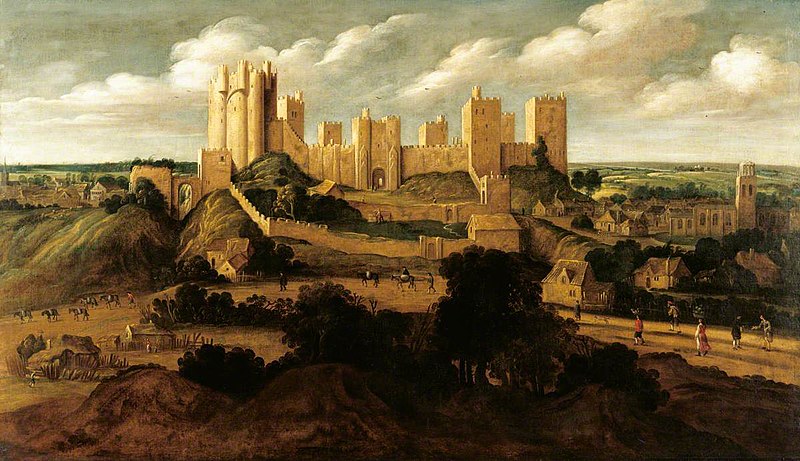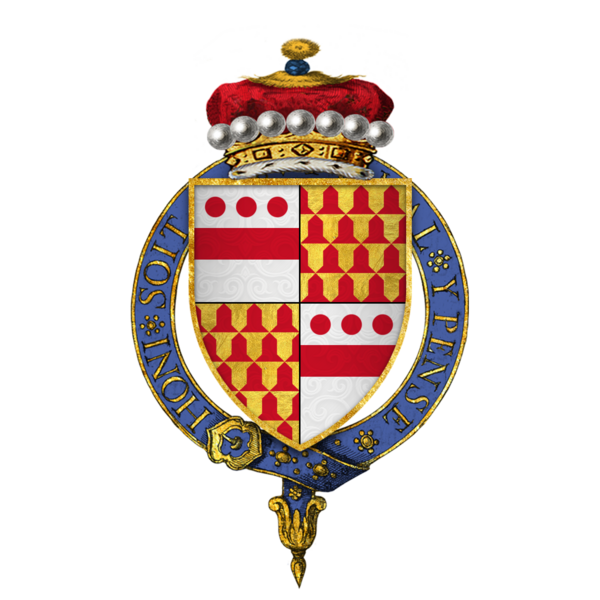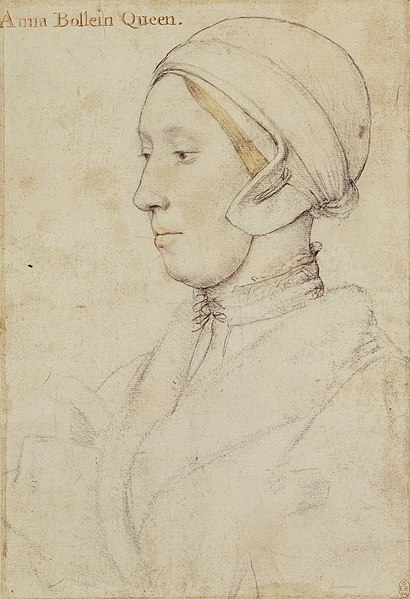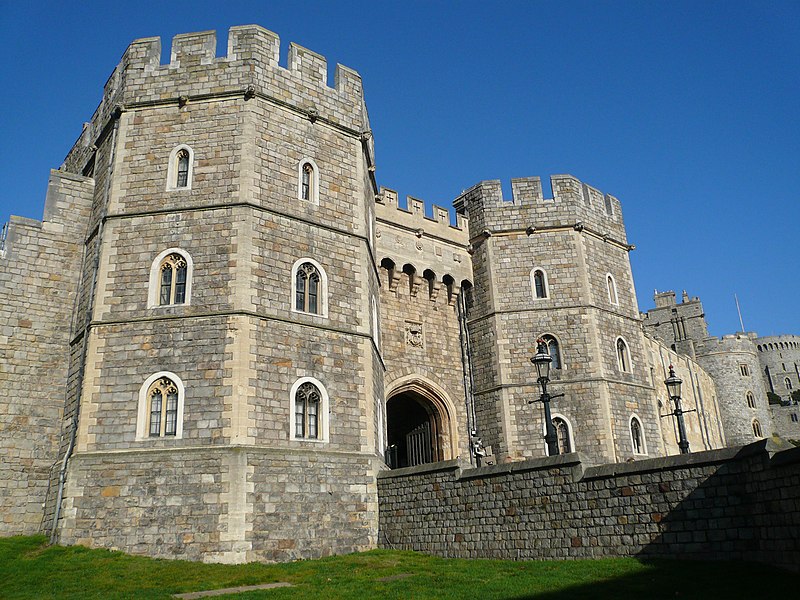 |
| 17th century painting of Pontefract Castle |
In 1528, as
the sweating sickness swept across the country, six people
died locally from the illness. Fitzroy’s council decided to move Fitzroy from Pontefract Castle[i] to Ledstone three miles away.
Fitzroy and six attendants stayed at a house belonging to the Prior of St
John’s. Fitzroy’s household was meant to include a doctor, but one had never
been appointed by Wolsey. And now the council worried that Fitzroy was without
medical care at this ‘time of strange
infirmities’.
Throughout
Fitzroy’s absence in the north Henry had continued to write to his son and sent
messengers with messages and gifts. On one occasion Fitzroy received a collar
of gold set with seven white enamel roses; in this emergency Henry sent a
selection of medical remedies for which Fitzroy thanked his father and assured
him that they had made all the difference in ensuring his continued good
health.
Henry and
Wolsey’s concern over the cost of the household in the north was borne out by
the continual over-expenditure. Much of this was for unbudgeted items; in
October 1527 a band of 60 soldiers had to be hired to deal with outlaws. The
cost of the troop came to £120[ii]
for two months, expensive especially as the intended outlaw, Sir William Lisle,
made no appearance.
Failure to
collect rents on Richmond’s behalf only added to the difficulties and officers
of the crown went unpaid. At one point the council had to borrow £500[iii]
from the Abbot of St Mary’s in York. More than once the council
applied to Wolsey in arrears, anticipating that the debt might be forgiven.
The dire
straits the council found itself in, was not helped by the lack of a Clerk of the Green Cloth. The position was not filled until
August 1526 and it took the clerk and Thomas Magnus until February the
following year to ascertain exactly where economies could be made. Eighteen
members of the household were discharged.
Henry
immediately demanded that some of the discharged officers be readmitted to
their duties. Fitzroy’s steward Sir William Bulmer[iv] and his comptroller Sir Thomas Tempest defended their actions and complaining that these new
instructions;.
‘[Made] all our orders and
directions to be of little regard; and we and all other officers and Councilors
here be lightly esteemed among our Lord’s servants.’[v]
Fitzroy’s
tenure as Warden of the Marches was finished when he handed over the reins to Lord William Dacre and returned to court in June 1529.
At Court
 |
| Lord Ferrers' arms |
On 22nd June Fitzroy was named Lord
Lieutenant of Ireland; a three man executive board made up of members of
the Irish
Privy Council was created to run Ireland on Fitzroy’s behalf. A
year later, Henry appointed Sir
William Skeffington as Lord
Deputy; Skeffington was sent to Ireland accompanied by an armed retinue to
rule in Fitzroy’s name[vi].
On 9th August the 10 year old Fitzroy attended the first
parliament called since he became duke; he sat in his ducal robes in prime
position between his father and Norfolk. During the proceedings the granting of
Fitzroy’s lands and possessions, were confirmed.
During the time Fitzroy was in London he was given ‘a grey trotting nag’ by Lord
Ferrers. Courtiers were more than happy to pay attention to the small boy
who was clearly in his father’s good books. Ferrers was not the only courtier
to give Fitzroy gifts.
 |
| Hatfield House Old Palace |
At Christmas Fitzroy attended the festivities at Greenwich where his father
bestowed upon him a two handled gilt cup and two little gilt pots as his New
Year’s gift. Henry not only gave Fitzroy gifts, he spent time with him, when
Henry could divert attention from Anne Boleyn. In the spring of 1531 Fitzroy
stayed at Hatfield with his
father and the following year he stayed at Grafton with the
king.
Fitzroy’s return to court meant an overhaul of his wardrobe and
household items; many of his furnishings were shabby and needed replacing. His
robes of state had been made for a six-year old boy; they were too small.
Norfolk was involved in the giving away of Fitzroy’s cast off furniture and
household ephemera. Several pieces were given to Fitzroy’s half-brother George,
now Lord Tailboys. Norfolk also paid for some replacement items out of his own
purse. When not at court, Fitzroy spent time at Wolsey’s manor of the More[vii] in Hertfordshire.
Loss of a Godfather
 |
| Anne Boleyn by Holbein |
By the time
of Fitzroy’s return Henry had become restless under Wolsey’s rule. To add to his sins Wolsey appeared
unable to produce the necessary divorce from Queen Catherine, so that Henry
could marry that beguiling witch Anne Boleyn, Norfolk’s niece. Henry had come under Anne’s spell in 1526[viii].
Fitzroy’s return to court was virtually unnoticed as all attention was on the Legatine court, convened at Blackfriars, considering Henry’s demand for a
divorce.
As Anne’s
power waxed, so Wolsey’s waned. And as the great divorce issue, ongoing since
1527, continued unresolved so Wolsey’s hold
on Henry slackened. The pope, a prisoner of the Emperor’s, was not going to
allow Henry to divorce the Emperor’s aunt. Croke’s recall from Sherriff Hutton eighteen
months earlier had been to help put together a legal case for the divorce.
Additionally
by 1529 Henry was concerned about the direction of his chancellor’s foreign
policy, in direct opposition to his own; Wolsey favoured the French while Henry
became increasingly desperate for a union with the Hapsburgs[ix].
Living at Windsor
.JPG/449px-Hans_Holbein_the_Younger_-_Thomas_Howard%2C_3rd_Duke_of_Norfolk_(Royal_Collection).JPG) |
| The Duke of Norfolk by Holbein |
With
Wolsey’s fall from grace and subsequent death in November 1530[x]
the Duke of Norfolk seized the chance of gaining influence over the king’s son.
He angled for his 12 year old son Henry Howard, Earl of Surrey, to become Fitzroy’s companion. Norfolk confided in Chapuys, the Imperial ambassador; Norfolk hoped that Surrey;
‘May in time become
[Richmond’s] preceptor and tutor that he may attain both knowledge and virtue.’[xi]
Norfolk was
given the custody and control of Fitzroy’s education that had formerly been
Wolsey’s prerogative. Norfolk took care to ensure that Surrey and Fitzroy spent
a lot of time together; the pair became inseparable friends despite the age
difference. The unsuitable George Cotton was named as Fitzroy’s Governor, but
Norfolk took over the matters that Wolsey had previously arranged for Fitzroy.
Fitzroy was
given apartments[xii]
in Windsor Castle that he shared with Surrey who, along with other young sprigs of the nobility,
joined Fitzroy for classes, tennis, dancing and sport. Fitzroy enjoyed hunting
and pursued prowess in the tiltyard in emulation of his father. In 1530 the
court came to Windsor when the king held a chapter of the Order of the Garter
at the castle to mark St George’s Day.
 |
| Henry VIII gateway, Windsor Castle |
After
the formalities of the Order’s celebration of mass in the St George’s Chapel Henry spent time with
his son. Fitzroy may have impressed his father with his archery skills as Henry
paid 20 shillings[xiii]
out of his privy purse, to his fletcher for new arrows for Fitzroy.
Henry’s
affection for Fitzroy was obvious and was remarked on by foreign ambassadors
reporting back to their courts. Even during the height of his affair with Anne,
Henry spent time with his son. In May 1531 Henry was back at Windsor and bought
Fitzroy a lute.
For her part
Anne Boleyn did not seem as taken with Fitzroy; the horse she gave him upon his
return to court was considered unsuitable for a young boy and was passed on to Gerald Fitzgerald, Earl of Kildare and former Lord Deputy of Ireland.
Bibliography
The Ebbs and
Flows of Fortune – David M Head, University of Georgia Press 2009
House of
Treason – Robert Hutchinson, Phoenix 2009
Henry VIII –
Robert Lacey, Weidenfeld & Nicholson & Book Club Associates 1972
The Earlier
Tudors – J D Mackie, Oxford University Press 1992
Cardinal
Wolsey – Mandell Creighton, MacMillan & Co 1891
Bastard
Prince – Beverley A Murphy, Sutton Publishing 2001
Rivals in
Power – David Starkey, MacMillan London Ltd 1990
The Six
Wives of Henry VIII – Alison Weir, Pimlico 1992
The Lost
Tudor Princess – Alison Weir, Vintage 2015
www.wikipedia.en
[i]
Where Fitzroy and his entourage spent the winters
[ii]
In 2014
the relative: historic standard of living value of that income or wealth is £73,480.00 labour earnings of that income or wealth is
£809,600.00 economic status value of that income or wealth is £2,459,000.00 economic power value of that income or
wealth is £35,410,000.00 www.measuringworth.com
[iii]
In 2014
the relative: historic standard of living value of that income or wealth is £340,800.00 labour earnings of that income or wealth is
£3,311,000.00 economic status value of that income or wealth is £10,610,000.00 economic power value of that income or
wealth is £154,300,000.00 www.measuringworth.com
[v]
Bastard Prince - Murphy
[vi]
There is no evidence to show why Henry removed the council and returned to the
old style of governance; he may have been concerned that Ireland could be used
as marshalling point for any foreign invasion of his realm. Skeffington had a
small army to see off anyone so inclined
[vii]
Queen Catherine lived here after the annulment of her marriage
[ix]
The major power on the continent
[x]
See http://wolfgang20.blogspot.co.uk/search/label/Cardinal%20Wolsey
for further details of Wolsey’s fall
[xi]
Bastard Prince - Murphy
[xii]
A new lodging known as the prince’s
lodging was later built on the western side of the north front
[xiii] In 2015 the relative: real price of that commodity is £555.90 labour value of that commodity is £5,703.00 income value of that commodity is £18,090.00 www.measuringworth.com
a strange and lonely life, no wonder he took to a companion not too many years his senior. if he was reared like Henry he probably came across as old for his years anyway.
ReplyDelete